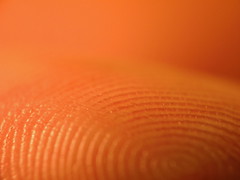A story of failed biometrics at a gym

![]() photo credit: kevindooley
photo credit: kevindooley
From Jake Vinson’s “Cracking your Fingers” (The Daily WTF: 28 April 2009):
A few days later, Ross stood proudly in the reception area, hands on his hips. A high-tech fingerprint scanner sat at the reception area near the turnstile and register, as the same scanner would be used for each, though the register system wasn’t quite ready for rollout yet. Another scanner sat on the opposite side of the turnstile, for gym members to sign out. … The receptionist looked almost as pleased as Ross that morning as well, excited that this meant they were working toward a system that necessitated less manual member ID lookups.
…
After signing a few people up, the new system was going swimmingly. Some users declined to use the new system, instead walking to the far side of the counter to use the old touchscreen system. Then Johnny tried to leave after his workout.
… He scanned his finger on his way out, but the turnstile wouldn’t budge.
“Uh, just a second,” the receptionist furiously typed and clicked, while Johnny removed one of his earbuds out and stared. “I’ll just have to manually override it…” but it was useless. There was no manual override option. Somehow, it was never considered that the scanner would malfunction. After several seconds of searching and having Johnny try to scan his finger again, the receptionist instructed him just to jump over the turnstile.
It was later discovered that the system required a “sign in” and a “sign out,” and if a member was recognized as someone else when attempting to sign out, the system rejected the input, and the turnstile remained locked in position. This was not good.
The scene repeated itself several times that day. Worse, the fingerprint scanner at the exit was getting kind of disgusting. Dozens of sweaty fingerprints required the scanner to be cleaned hourly, and even after it was freshly cleaned, it sometimes still couldn’t read fingerprints right. The latticed patterns on the barbell grips would leave indented patterns temporarily on the members’ fingers, there could be small cuts or folds on fingertips just from carrying weights or scrapes on the concrete coming out of the pool, fingers were wrinkly after a long swim, or sometimes the system just misidentified the person for no apparent reason.
Fingerprint Scanning
In much the same way that it’s not a good idea to store passwords in plaintext, it’s not a good idea to store raw fingerprint data. Instead, it should be hashed, so that the same input will consistently give the same output, but said output can’t be used to determine what the input was. In biometry, there are many complex algorithms that can analyze a fingerprint via several points on the finger. This system was set up to record seven points.
After a few hours of rollout, though, it became clear that the real world doesn’t conform to how it should’ve worked in theory. There were simply too many variables, too many activities in the gym that could cause fingerprints to become altered. As such, the installers did what they thought was the reasonable thing to do – reduce the precision from seven points down to something substantially lower.
The updated system was in place for a few days, and it seemed to be working better; no more people being held up trying to leave.
Discovery
… [The monitor] showed Ray as coming in several times that week, often twice on the same day, just hours apart. For each day listed, Ray had only come the later of the two times.
Reducing the precision of the fingerprint scanning resulted in the system identifying two people as one person. Reviewing the log, they saw that some regulars weren’t showing up in the system, and many members had two or three people being identified by the scanner as them.
A story of failed biometrics at a gym Read More »